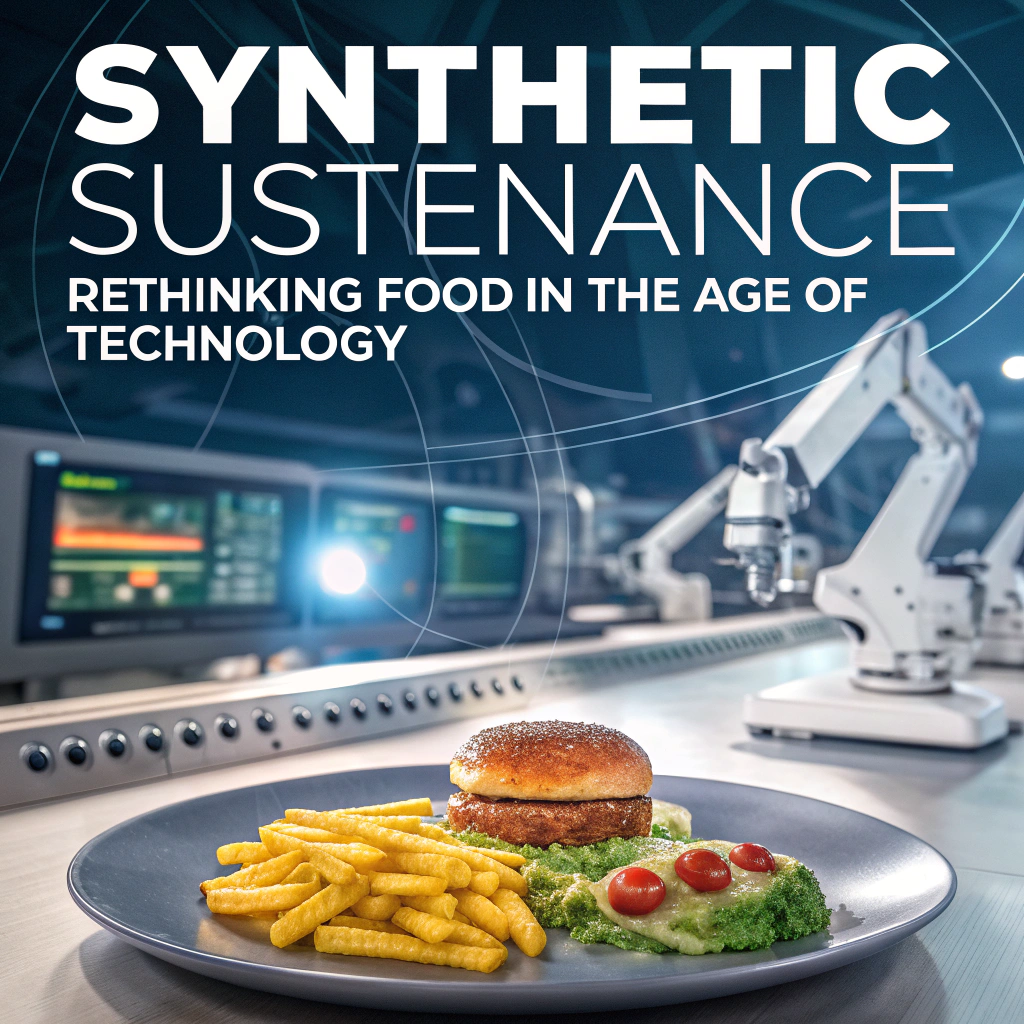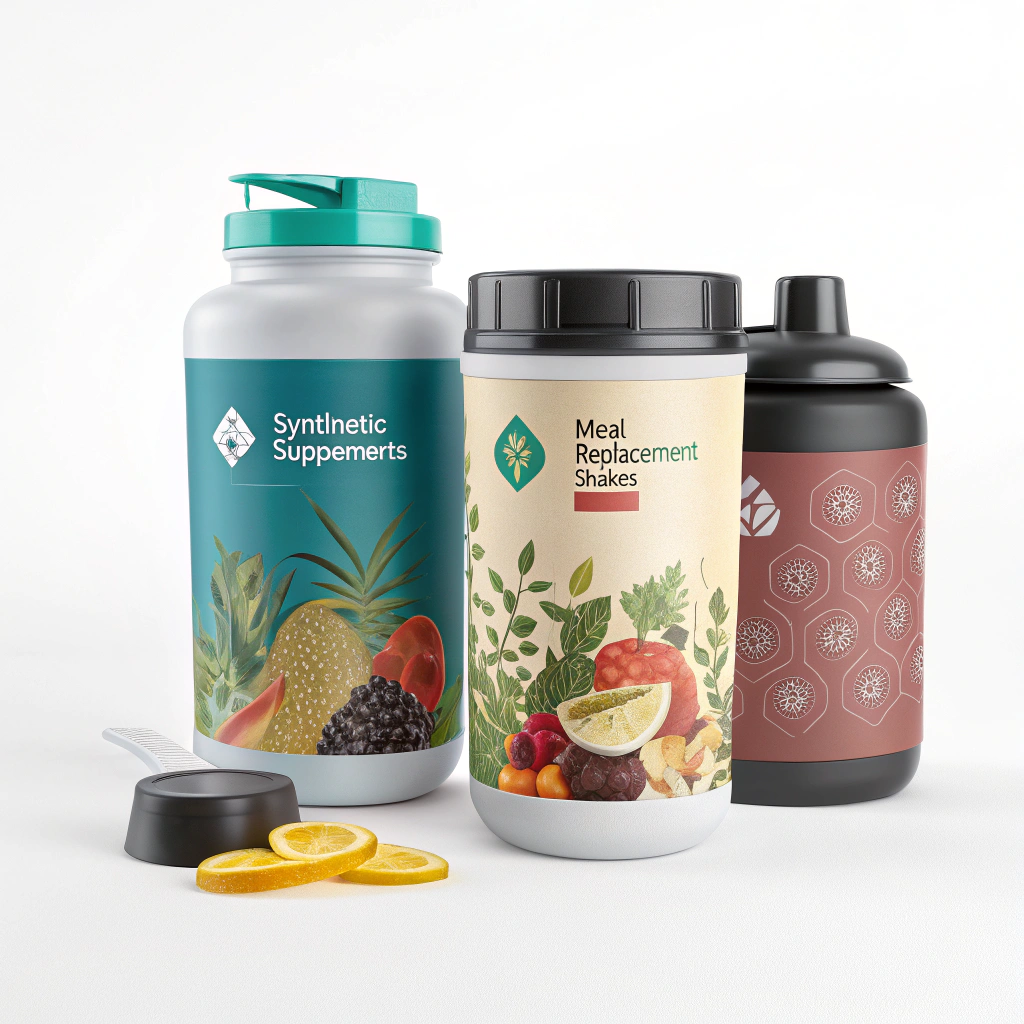Synthetic Sustenance: Rethinking Food in the Age of Technology
Introduction
In a world facing profound challenges—from climate change and population growth to food insecurity and resource scarcity—the way we produce, distribute, and consume food is being reimagined. Traditional agriculture, while foundational to civilization, is under strain. It depletes natural resources, emits vast amounts of greenhouse gases, and often relies on exploitative labor and unsustainable practices. Enter the era of synthetic sustenance—a bold new vision for food forged at the intersection of science, technology, and innovation.
Synthetic sustenance refers to food that is designed, engineered, or produced through non-traditional, technology-driven methods. This includes lab-grown meat, precision-fermented dairy, AI-designed meal systems, bioengineered crops, and functional foods made using synthetic biology. In this age of rapid technological advancement, we’re not just feeding ourselves—we’re rethinking the very essence of food.
This article explores the rise of synthetic sustenance, the technologies behind it, its potential to transform society, and the ethical, ecological, and cultural implications of our evolving relationship with food.

1. What Is Synthetic Sustenance?
Synthetic sustenance encompasses a broad range of technology-enabled food innovations designed to solve modern challenges around nutrition, sustainability, and accessibility. These foods are often created in laboratories, controlled environments, or through digital platforms rather than grown or raised in traditional ways.
Key Categories Include:
- Cultivated (Lab-Grown) Meat: Meat produced from animal cells without slaughter.
- Precision Fermentation: Microorganisms programmed to produce animal-free dairy, eggs, or fats.
- 3D-Printed Food: Layer-by-layer creation of complex meals using edible ingredients.
- Bioengineered Crops: Genetically modified to resist pests, grow faster, or contain enhanced nutrition.
- AI-Personalized Meals: Foods tailored to an individual’s health data, microbiome, or genetic profile.
- Meal Replacements: Nutritionally complete synthetic products (e.g., Soylent, Huel) designed for convenience and efficiency.
Synthetic sustenance isn’t about abandoning natural foods—it’s about complementing or enhancing them with tools that are smarter, cleaner, and more sustainable.
2. The Drivers Behind the Shift
A. Environmental Strain
Agriculture accounts for nearly 30% of global greenhouse gas emissions. Livestock farming alone contributes to deforestation, water depletion, and methane emissions. Synthetic alternatives like lab-grown meat or plant-based proteins can dramatically reduce these environmental impacts.
B. Population Growth
With the global population projected to reach 9.7 billion by 2050, demand for food will outstrip current production methods. Traditional agriculture cannot scale without exacerbating ecological damage. Synthetic foods offer a scalable, urban-friendly alternative.
C. Health and Nutrition
Malnutrition exists on both ends of the spectrum—undernourishment and obesity. Synthetic sustenance enables precision nutrition, tailoring food to the unique needs of individuals or populations to combat chronic disease and nutritional deficiencies.
D. Ethical Considerations
Factory farming, animal suffering, and labor exploitation have led to rising demand for ethical alternatives. Synthetic foods offer cruelty-free options that align with emerging ethical values.
3. Cultivated Meat: Real Protein, No Slaughter
Perhaps the most headline-grabbing example of synthetic sustenance is lab-grown meat, also known as cultivated meat.
How It Works:
- A small sample of animal cells is extracted.
- These cells are grown in a nutrient-rich medium inside a bioreactor.
- Over time, they multiply and form tissue that can be harvested as meat.
The result is real meat—identical in taste and texture—but without killing animals, using antibiotics, or requiring massive land and water resources.
Current Progress:
- Eat Just sold the first lab-grown chicken in Singapore (2020).
- UPSIDE Foods and GOOD Meat received approval for sale in the U.S. (2023).
- Companies like Mosa Meat and Aleph Farms are working on cultivated steak and pork.
Environmental Impact:
- Uses up to 96% less water
- Reduces greenhouse gases by 80–90%
- Requires no antibiotics or hormones
4. Fermentation: The Microbial Revolution
While fermentation is ancient, precision fermentation is cutting-edge. It involves programming microorganisms (like yeast or fungi) to produce specific proteins, fats, or nutrients.
Applications:
- Perfect Day makes dairy proteins without cows.
- Clara Foods creates egg whites from yeast.
- Motif FoodWorks develops animal-free flavor compounds.
This microbial approach can recreate the taste and function of animal products with less land, fewer emissions, and zero animals.
5. Synthetic Supplements and Meal Replacements

Meal replacements like Soylent, Huel, and Mana represent an early form of synthetic sustenance. Designed to deliver complete nutrition in a single serving, these powdered or liquid meals appeal to busy professionals, astronauts, and survivalists alike.
Now, synthetic meal systems are moving toward:
- AI-designed formulations based on health data
- Bioavailability optimization for better nutrient absorption
- Customized micronutrient profiles for individual needs
Though often criticized for being impersonal or unappealing, they offer a glimpse into the future of efficiency-based eating.
6. AI and Personalized Nutrition
Smart devices and artificial intelligence are enabling next-generation dietary personalization.
How It Works:
- DNA or microbiome tests reveal individual traits.
- Wearables track metabolism, glucose, heart rate, and sleep.
- AI algorithms recommend food combinations, supplements, and meal times.
Key Platforms:
- ZOE: Uses microbiome and blood sugar data to tailor meal plans.
- Viome: Offers gut-focused nutrition insights.
- Levels: Uses real-time glucose data for food optimization.
This level of customization can help manage or prevent diseases like diabetes, IBS, and heart disease—through data-driven eating.
7. Bioengineered and Genetically Modified Foods
Synthetic biology allows us to edit genes and enhance food traits in crops and animals.
Examples:
- Golden Rice: Engineered with vitamin A to combat deficiency.
- CRISPR-modified tomatoes with increased shelf life.
- Gene-edited mushrooms that don’t brown.
These foods are more resilient, nutrient-dense, and sustainable—though they also raise debates around GMO labeling, safety, and consumer choice.
8. 3D-Printed Food: Culinary Meets Coding

Food printers use edible ingredients like purées, doughs, or plant proteins to create complex shapes and textures, layer by layer.
Applications:
- Reconstructing lab-grown meat into steaks.
- Making customized meals in hospitals or care homes.
- Turning waste ingredients into attractive dishes.
As hardware advances, chefs and food scientists may co-design entirely new categories of cuisine—blending gastronomy with geometry and chemistry.
9. Ethical, Social, and Cultural Questions
What Is “Natural”?
As food becomes more artificial, we must reconsider our definitions of “natural,” “real,” and “authentic.” Is a lab-grown burger less real than one from a factory farm?
Consumers often resist synthetic food because of:
- The “yuck” factor
- Concerns about processing
- Cultural attachments to traditional food
Overcoming these requires transparent labeling, public education, and engaging storytelling about the science and benefits.
Food Equity and Access
There’s a risk that synthetic foods will serve only the wealthy. Democratizing access will require:
- Government subsidies
- Open-source technologies
- Partnerships with developing nations
Synthetic sustenance must be a solution for everyone, not just a luxury for a few.
10. Regulatory and Safety Considerations
Governments are still adapting to the fast pace of food tech innovation.
Key regulatory questions include:
- What counts as meat or dairy?
- How should synthetic foods be labeled?
- What safety protocols are required?
The FDA, EFSA, and Codex Alimentarius are working to define standards. Without global alignment, innovation may stall or cause confusion.
11. Sustainability and Climate Benefits
Synthetic sustenance offers significant ecological advantages:
| Traditional Food | Synthetic Alternative | Environmental Benefit |
|---|---|---|
| Beef steak | Cultivated steak | 80%+ fewer emissions |
| Dairy milk | Fermented whey | No methane, less land |
| Soy farm | Bioengineered microgreens | Faster growth, less land |
| Fish | Lab-grown salmon | No overfishing, cleaner oceans |
As planetary boundaries tighten, synthetic food systems may be our best hope for decoupling nutrition from environmental destruction.
12. The Future of Eating: 2040 and Beyond
In 2040, your breakfast might include:
- A 3D-printed omelet made from mung beans and bioengineered spices
- A microbiome-optimized yogurt created from precision fermentation
- A lab-grown bacon strip with a QR code verifying its carbon-neutral status

